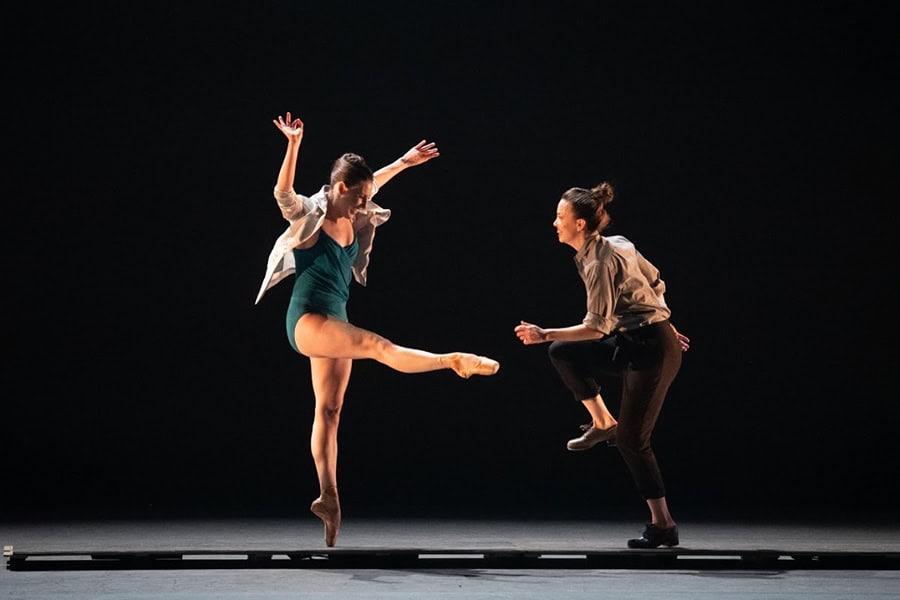Turn It Out with Tiler Peck & Friends at Sadler’s Wells
Posted: March 18th, 2023 | Author: Nicholas Minns & Caterina Albano | Filed under: Performance | Tags: Aaron Marcellus Sanders, Alonzo King, Brooklyn Mack, Byron Tittle, Caroline Shaw, James Blake, Jillian Meyers, Lex Ishimoto, Michelle Dorrance, Penelope Wendtlandt, Roman Mejia, Shu-Wei Tseng, Tiler Peck, William Forsythe | Comments Off on Turn It Out with Tiler Peck & Friends at Sadler’s WellsTiler Peck, Turn It Out with Tiler Peck & Friends, Sadler’s Wells, March 9, 2023

In William Forsythe’s The Barre Project, Blake Works II, which concludes Turn It Out with Tiler Peck & Friends, Peck works out the choreographic problems with such elegance and clarity that inherent in her response is the quality of the challenge that provoked it. Forsythe is a brilliant innovator of the use of classical technique in the way George Balanchine was; it is perhaps not surprising that Forsythe found in Peck, who trained at Balanchine’s School of American Ballet and rose to principal in the New York City Ballet, a dancer who knows instinctively how to absorb such innovation into her own technical repertoire and deliver a scintillating interpretation. Peck is joined in The Barre Project by fellow NYCB dancers, Lex Ishimoto and Roman Mejia, while Brooklyn Mack completes the quartet. Created during lockdown, entirely over Zoom — like some kind of haptic online surgery — The Barre Project, to the music of James Blake, took three months to conceive and a matter of days of studio work at CLI Studios to bring the four dancers together for its initial digital performance on March 25, 2021. Forsythe wrote at the time that, ‘Irrespective of genre, a dancer’s irrepressible capacity to summon fierce joy through their work gives testament to the resilience of the human spirit.’ He could have been talking not only about The Barre Project but of the entire evening Peck has devised and delivered to Sadler’s Wells audiences.
Turn It Out with Tiler Peck & Friends highlights Peck’s love of producing, of finding works from other choreographers that challenge her own way of dancing and at the same time that accord with her vision of a show. And this is very much a ‘show’ in the Broadway sense: a unity of vision formed of diverse numbers. Peck, who according to Michelle Dorrance, ‘lives at the intersection of so many dance forms’, is clearly the source for this unity. The different numbers include, in running order, her own choreography in contemporary classical style; a philosophical duet by Alonzo King; an exuberant collaboration in tap and ballet for the full ensemble by Dorrance, Peck and Jillian Meyers, and Forsythe’s blindingly lyrical paean to classical ballet. What flows through the entire program is a palpable sense of consummate musicality.
The only reason Peck does not dance in the first piece, Thousandth Orange, is that she expressly choreographed it on six colleagues while recovering from a herniated disc. Used to choreographing on her own body, the work reflects a certain reticence in dynamics while focusing on the fluid continuation of form and, one can’t help feeling, a desire for healing. The dynamic that permeates the movement, derived from Caroline Shaw’s exquisite quartet of the same name, played live on stage, is one of precise, sensual form reacting to the rippling of the wind.
Peck was drawn to the philosophical approach of choreographer Alonzo King by his belief that ‘dance is thought made visible, just as music is thought made audible.’ Inspired by his reading of the Upanishads, King created Swift Arrow for Peck and Mejia to the piano solo of the same name by Jason Moran (played on stage by Shu-Wei Tseng). The swift arrow of the title is ‘the disciplined mind’ fixed on its objective of oneness, and Peck translates this lucidly in her opening solo of sinuous lines and forms while the bare-chested Mejia looks on. Peck’s dynamic strength, however, is in marked contrast to the unseemly force Mejia employs when he comes to string his own bow: the disciplined mind of classical technique has been deflected in the gym, leaving King’s goal of uniting the two spheres tantalisingly unfulfilled.
Time Spell, with choreography by Dorrance, Meyers and Peck ‘in collaboration with and improvisation by the dancers’ (not to mention assistant choreographer Byron Tittle) has a subtitle that captures its spirit and the post-pandemic environment in which it was created: ‘subdivisions of time and space, and intersections of isolation and community, longing and joy.’ Layered around the superb a cappella voices of Aaron Marcellus Sanders and Penelope Wendtlandt, Time Spell builds up an intense sense of community and brings the house down. On the way home on the bus I asked a lady clutching her program if she liked the show. ‘Oh yes’, she replied, ‘but I thought the third piece should have closed the evening.’ She has a point, from a purely theatrical perspective, but The Barre Project also sends out a consummate signal that the benchmark of ballet has been irrevocably raised.